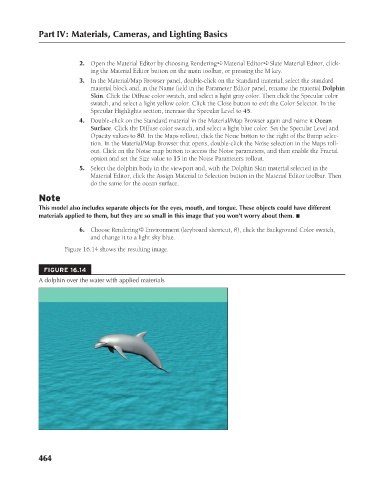Page 512 - Kitab3DsMax
P. 512
Part IV: Materials, Cameras, and Lighting Basics
2. Open the Material Editor by choosing Rendering ➪ Material Editor ➪ Slate Material Editor, click-
ing the Material Editor button on the main toolbar, or pressing the M key.
3. In the Material/Map Browser panel, double-click on the Standard material; select the standard
material block and, in the Name field in the Parameter Editor panel, rename the material Dolphin
Skin. Click the Diffuse color swatch, and select a light gray color. Then click the Specular color
swatch, and select a light yellow color. Click the Close button to exit the Color Selector. In the
Specular Highlights section, increase the Specular Level to 45.
4. Double-click on the Standard material in the Material/Map Browser again and name it Ocean
Surface. Click the Diffuse color swatch, and select a light blue color. Set the Specular Level and
Opacity values to 80. In the Maps rollout, click the None button to the right of the Bump selec-
tion. In the Material/Map Browser that opens, double-click the Noise selection in the Maps roll-
out. Click on the Noise map button to access the Noise parameters, and then enable the Fractal
option and set the Size value to 15 in the Noise Parameters rollout.
5. Select the dolphin body in the viewport and, with the Dolphin Skin material selected in the
Material Editor, click the Assign Material to Selection button in the Material Editor toolbar. Then
do the same for the ocean surface.
Note
This model also includes separate objects for the eyes, mouth, and tongue. These objects could have different
materials applied to them, but they are so small in this image that you won’t worry about them. n
6. Choose Rendering ➪ Environment (keyboard shortcut, 8), click the Background Color swatch,
and change it to a light sky blue.
Figure 16.14 shows the resulting image.
FIGURE 16.14
A dolphin over the water with applied materials
464
6/30/10 4:24 PM
24_617779-ch16.indd 464
24_617779-ch16.indd 464 6/30/10 4:24 PM

